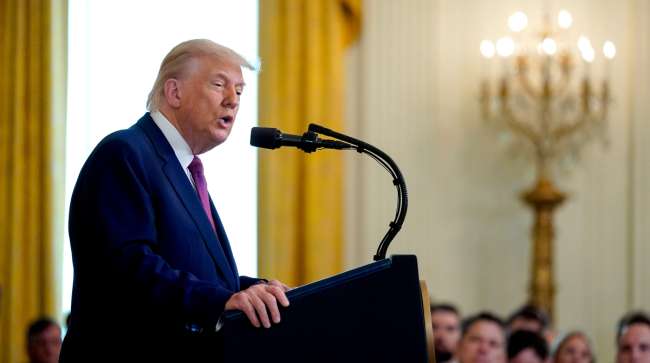Trump came into office promising to radically remake the U.S.-China trade relationship and force Beijing to open markets to more American goods. (Al Drago/Bloomberg)
President Donald Trump is hailing the latest trade framework with China as a game-changing breakthrough. Yet the deal he touted June 11 represents little more than a reset back to earlier terms — and even that came at a cost.
After fresh negotiations in London, tariff rates remain essentially unchanged. Rare earth shipments from China are set to return to pre-April 2 conditions. Meanwhile, a slew of thornier issues, including trade imbalances and malign activity, remain unresolved.
While Trump cast the understanding as “GREAT” in a social media post on June 12, his team acknowledged it largely formalized terms agreed to last month in Geneva, many of which are still shrouded in mystery. To seal the deal, the U.S. had to roll back a promised crackdown on visas for Chinese students. And the back-and-forth exposed that key U.S. industries are reliant on magnets largely sourced from China.
“This is basically just a reset that’s being packaged by the administration as a substantive agreement,” said Tim Meyer, a professor of international trade law at Duke University’s law school. “It’s possible in the future, China may have a stronger hand.”
Trump came into office promising to radically remake the U.S.-China trade relationship and force Beijing to open markets to more American goods. Recent developments illustrate the difficulty of solving those problems, which have vexed each of the past three presidents.
“We’re going to be opening up China. That’s bigger than what we signed and I think had we not signed it, that wouldn’t be happening,” Trump said June 12 at the White House. “It’s going to happen fairly soon.”
Going forward, China holds a strong hand because of its dominance supplying rare-earth materials that are essential ingredients in mobile phones, semiconductors and other technology. Trump also made clear how important those stocks are to the U.S., appearing far more eager than Chinese President Xi Jinping to get talks back on track by pining for a phone call for months.

Xi. (Dado Galdieri/Bloomberg)
What’s more, Trump’s practice of making sweeping tariff threats — only to back down later — has signaled to other world leaders even modest concessions can secure retreats. Investors have grown so used to the pattern they’ve adopted the acronym “TACO” — or “Trump Always Chickens Out” — to describe the phenomenon.
“This is a Chinese TACO,” said Scott Kennedy, a China expert at the Center for Strategic and International Studies. “They have seen him in previous instances back down. They made a calculated gamble that he would back down and he did.”
Rare Earths, Student Visas at Center of Narrow Talks
The London talks were narrow by design — meant to touch on issues covered in Geneva — and therefore focused on matters such as rare earths rather than more sweeping problems including the U.S. trade deficit with China, a White House official said.
Trump has said Beijing has more to lose in a trade war with the U.S., with its economy facing risks from losing access to the American market, and the recent flare-up underscored that vulnerability, the official said.
Trade tensions between the U.S. and China exploded in April, when Trump imposed escalating tariffs on Beijing — reaching as high as 145% — and Xi’s government retaliated with its own levies and new curbs on rare earth exports.
The two countries lowered the duties in May following two days of trade talks in Geneva, but rates didn’t budge further after this week’s London negotiations. Trump said June 11 the U.S. is imposing a 55% tariff on Chinese imports, essentially matching the levels he first laid out April 2.
Trump’s Pattern Raises Questions About Credibility
The deliberations this week came after an extended clash over last month’s truce. U.S. officials accused China of stalling magnet shipments despite promises in Geneva, while Beijing vented anger with fresh Trump administration controls on chip design software, jet engines and student visas. After a call between Trump and Xi, the two sides agreed to sit down to find an off-ramp.
For the US president, who has long promoted himself as a dealmaker, reaching the agreements is often as important — if not more so — than their substance.
He also prioritizes getting quick deals done directly with counterpart leaders, in contrast with Xi who favors negotiations led by lieutenants in order to avoid being blindsided. It took most of Trump’s first term to land a “phase one” trade deal with China that ended years of tit-for-tat tariffs; even then, few of Beijing’s promised purchases of U.S. goods materialized.
This week’s announcement is not the final word on a China trade agreement — and it could provide a stepping stone toward a broader deal. Yet it’s also unclear the framework will even hold given that the previous accord quickly broke down. Next steps — such as a possible Trump-Xi meeting — are uncertain, though the U.S. president said the leaders had agreed to reciprocal visits.

China holds a strong hand because of its dominance supplying rare-earth materials that are essential ingredients in mobile phones, semiconductors and other technology. (Annabelle Chih/Bloomberg)
The gyrations risk jeopardizing Trump’s ability to secure more concessions in trade talks — especially with Beijing, said Leland Miller, chief executive officer of the China Beige Book and a member of the U.S.-China Economic and Security Review Commission.
“We keep ratcheting up the temperature and then ratcheting it back down, but returning to where we started isn’t going back to zero. It’s actually a net loss, because it eats up credibility along the way,” Miller said. “This is not just a return to the starting point; it’s giving Beijing ammunition.”
The relatively incrementally progress contrasts with Trump’s bold promises to immediately bring China to heel after years of “ripping off” the U.S.
And it portends further challenges as the Trump administration struggles to land a range of trade deals with other nations. So far, only one framework agreement, with the UK, has been finalized. Arrangements with India, Japan, the European Union and others remain works in progress.
U.S. Commerce Secretary Howard Lutnick declared June 11 that the White House is now turning to other deals, saying on CNBC that talks are in “good shape with lots of countries.” Trump also said he intended to send letters to trading partners setting unilateral tariff levels — again repeating an earlier threat to do so within two weeks.
Export Controls Emerge as New Trade Battleground
The U.S.-China talks also opened a new front in trade negotiations, putting export controls on the table in ways seen untenable before. China showed a new willingness to weaponize its rare earth supplies, and the U.S., in turn, curbed exports of plane parts, ethane used to make plastic and nuclear materials.
Lutnick signaled some of those export moves were meant to create leverage for negotiations with Beijing, telling CNBC: “If you want to annoy us, the United States of America under Donald Trump is strong enough to annoy you back equally.”
This suggests that some export controls imposed in the name of national security — and designed to keep sensitive technologies out of Beijing’s hands — are now up for negotiation.
U.S. officials have said, however, they’re steadfast on keeping blocks on the most advanced semiconductors. And Trump’s team has signaled it’s prepared to ramp up controls again if needed to secure rare earth flows.
Miller said haggling on export controls benefits Beijing. The U.S. exports at issue are equipment that can be used commercially in China or feed “their military machine,” Miller said. “Once you allow these things to be traded, you’re giving Beijing leverage that otherwise it does not have.”
Markets had a tepid reaction to the news June 11, indicating investors have started to become unmoved by Trump’s trade pronouncements.
Voters are growing increasingly skeptical of Trump’s trade agenda. A new Quinnipiac University poll, conducted from June 5-9, found that 57% of voters disapproved of his handling of trade.






